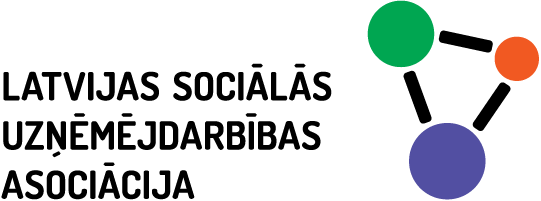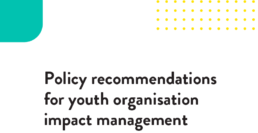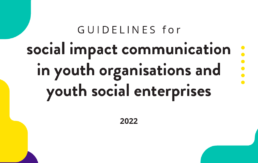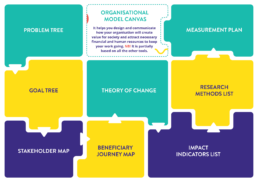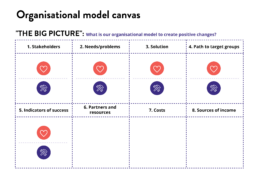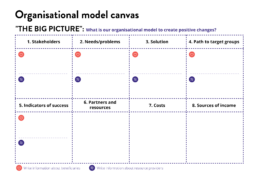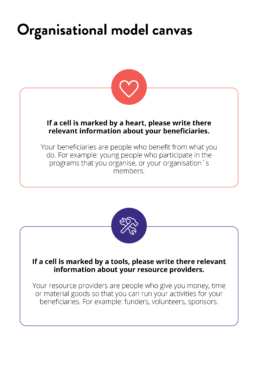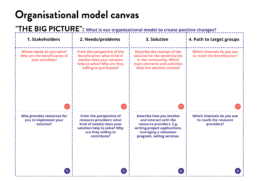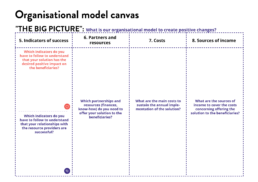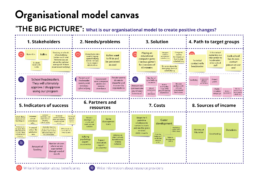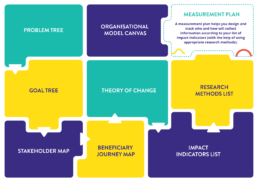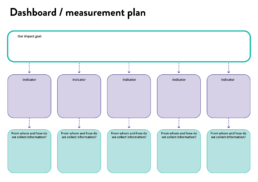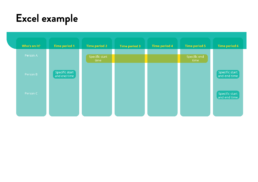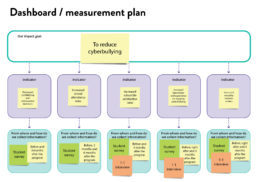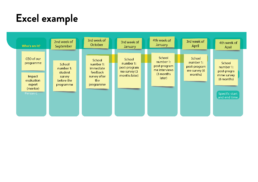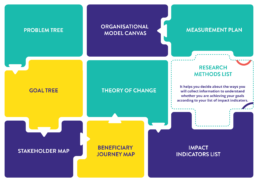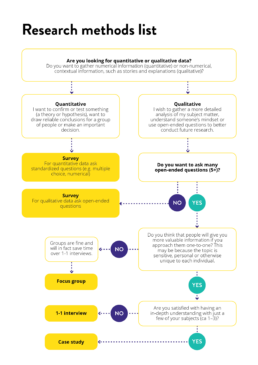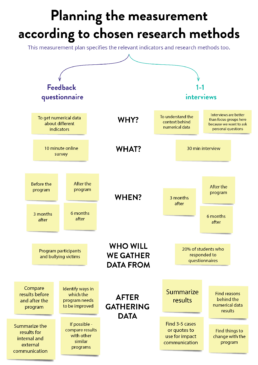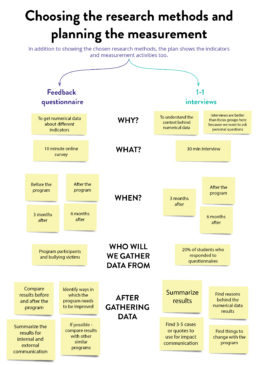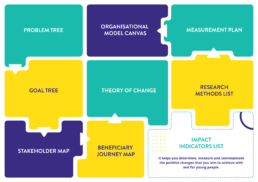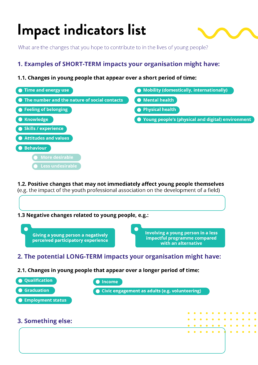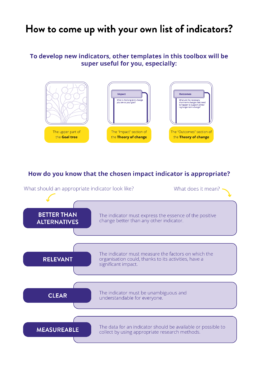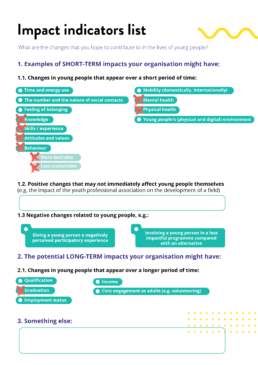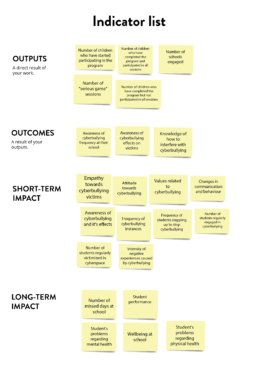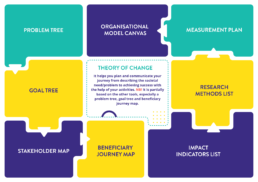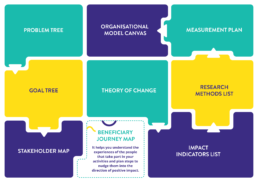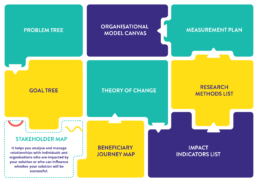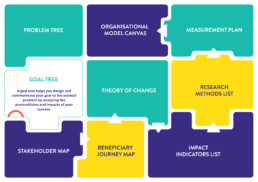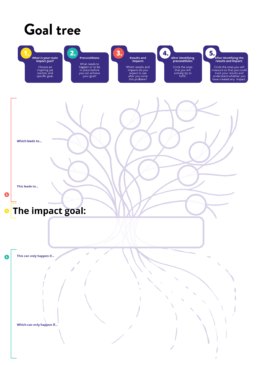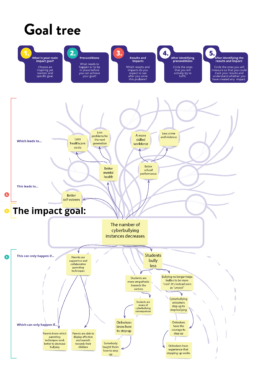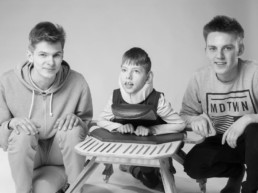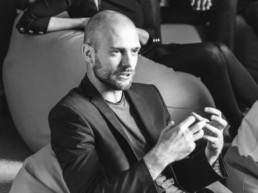Policy recommendations for impact management
Social Entrepreneurship Association of Latvia together with Baltic partners in the framework of BALTIC : YOUTH : IMPACT project have developed Policy Recommendation Guidelines for Social Impact Management of Youth Organisations.
Based on the findings, external research and expert opinion, we have identified the problem: “Youth organisations and social enterprises working with young people do not systematically increase and demonstrate their positive social impact”. And it allowed to formulate policy recommendations aimed at informing policy makers and lobbyists with a mandate to advocate for improvements in social impact and governance in the youth sector.
DOWNLOAD POLICY RECOMMENDATIONS
The guidelines will introduce the importance of social impact management in the daily work of youth organisations, provide practical recommendations to support the implementation of social impact management, present the Baltic States context and examples of good practice, and address in detail the main challenge, its root causes and potential consequences without framing social impact management as a systematic set of actions understood by all stakeholders.

Social Impact Communication
We understand the importance for organisations and social enterprises to manage their social impact, which makes it all the more important to communicate the social impact they are achieving to their audiences, staff and volunteers. Within the BALTIC : YOUTH : IMPACT project, the Social Entrepreneurship Association of Latvia together with Baltic partners have developed the Social Impact Communication Guidelines.
The aim of these guidelines is to create support tools to help staff or volunteers in youth organisations or social enterprises to communicate their social impact to the public in a clear and cost-effective way, thus supporting efforts to achieve better quality and better work of youth organisations and social enterprises.
The guidelines will help you to understand how to organise internal and external communication and how to choose the right communication message, provide examples of different communication tools, tips and advice, and important requirements to pay attention to when designing your communication.
DOWNLOAD THE SOCIAL IMPACT COMMUNICATION GUIDELINES
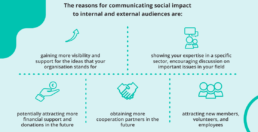
The communication guidelines will inspire you to communicate the social impact of your organisation or project to your internal and external audiences. If, after reading the guidelines, you still have doubts or feel that your organisation is too small and does not have enough resources to develop your own social impact communication strategy, do not be afraid to start with small steps. Start with simple activities such as preparing and collecting data.
By starting slowly, you can continue to grow and achieve great things – the more you talk about your organisation, the more likely you are to get more support and expand your team in the future.

Organisational model canvas
An organisational model canvas helps you design and communicate how your organisation will create value for society and attract necessary financial and human resources to keep your work going. NB! It is partially based on all the other tools.
Is it a business model canvas?
The business model canvas is a widely used tool for strategic management. Its main purpose is to help develop new business models, as well as document existing ones.
Many canvases have been developed, but Alexander Osterwalder’s conceptualization is the most common one. It’s a chart that consists of nine cells and helps people understand connections between them: key partners, key activities, key resources, value proposition, customer relationships, channels, customer segments, cost structure, and revenue streams. It helps the entrepreneurs visualize and communicate your business model or explore new ones.
A business model canvas is indeed a common tool for businesses. However, it’s usually not the best for (youth) organizations or other NGOs. Any business has to generate profit as its most important goal – that’s how the for-profit enterprises measure their success. A business model canvas helps them plan how to do what they do even better to generate bigger profits yet.
On the other hand, when you think about youth organizations or social enterprises working with young people, their first aim is to make a change. It can be for their members or the wider society, but money is mostly used as a means, not a goal by itself. Also, organizations’ opportunities, capacities, etc. can be quite different from those of for-profit companies, so it wouldn’t make sense to use the same approach for both of them.
The organisational canvas is a concise model of your organisation! It helps you to see for yourself and show to others what and how you would like to achieve the goals of your organisation. It combines information from all the previous tools with the facts about your organisation’s finances and partnerships.
Importantly, the organisational canvas helps you to analyse separately your beneficiaries as well as the stakeholders who provide you with resources to achieve your impact goals. After filling in the canvas you can see clearly your strengths and weaknesses in terms of management and content work of your organisation.
Watch the video to get an idea of what the tool is about or continue reading after the video player.
In more detail…
1.Fill in the information about all the cells either the way they are at the moment (if your organisation already exists) or how you imagine your organisation is in the future (if you’re in the process of establishing a new initiative).
2.Start analysing the situation (if your organisation already exists) or testing the assumptions whether the reality would really look like this (if you’re in the process of establishing a new initiative).
NB! Feel free to make adjustments to the tool when necessary.
You can also have variations in its use
LIGHT: Fill in the information according to your and your team’s knowledge.
MEDIUM to ADVANCED: As a preparatory work, use all the analytical tools related to the impact dimension (problem tree, goal tree, etc. leading to the Theory of Change) and other documents that your organization uses to run its activities (e.g. a communication plan).
Here is an example about a cyberbullying prevention program.
Why can it be super useful?
The organisational canvas is a concise model of your organisation showing the link between your impact, activities and needed resources! It helps you to see for yourself and show to others who you are and if you are moving in the right direction. The short, detailed and visual overview of your organization is helpful to understand what your aims are, who the stakeholders are, what your value proposition is, where your resources come from, etc.
When you fill in the canvas before starting a new organization, you can use it to clearly map out what the organization will do and what it will need. If your organization is already established, the canvas is useful for analysing and improving the management of the organisation, helping to point out strengths, weaknesses and opportunities. You can create the canvas from scratch or by using information from other tools.
Have you ever found it difficult to give a clear and brief overview of your organisation to other people (e.g. new team members, funders or even your friends)? The canvas can also be a wonderfully useful communication tool, showing everything that’s important about your organisation on one page.
Why to use it?
☑ To find out whether the way you’re combining or planning to combine all the activities makes sense.
☑To find out what are the essential components of your organisation to keep, improve or change.
☑ To help you explain the work of your organisation to others.
When to use it?
☑ If you´re planning to establish a new organisation, the canvas will help you to realistically imagine what would be needed to run the activities successfully.
☑ If your organisation already exists, you can first fill in the canvas according to you current situation and then use it as a tool to start improving your activities and impact (or communicating these clearly and briefly to others).

Measurement plan
A measurement plan helps you design and track who and how will collect information according to your list of impact indicators (with the help of using appropriate research methods).
What is it?
The measurement plan helps you keep track of your activities regarding impact measurement.
Essentially a combination of a calendar and checklist, it helps you first decide and then supervise who and how will collect information according to your list of impact indicators
The plan should be created before carrying out any impact measurement-related activities.
There are two interconnected tools: a big picture dashboard and an Excel example.
The measurement plan dashboard should be used to get started on planning. It helps you see a bigger picture, prioritize goals and indicators, decide on research methods.
The Excel example, however, lets you make arrangements based on what you’re planning to measure. You can assign specific tasks to your team members and set deadlines for them.
But how are these two templates connected?
If you don’t yet have a clear idea of why, what, when and by whom impact measurement activities should be carried out, it’s good to use the dashboard first. Then, you can use the input of the dashboard to develop an Excel table for tracking your progress.
Nevertheless, you can use just one of them if you feel like such a choice would be a better fit for your organization.
Watch the video to get an idea of what the tool is about or continue reading after the video player.
In more detail…
Start with filling in the measurement plan dashboard.
1.Write down your impact goal – this is a goal from the goal tree template that you’re going to focus on. You may have more of them, but it’s easier to pick one goal at first to keep your focus (and create separate dashboards for other goals if necessary).
2.Think of which aspects of this goal you can (and want to) measure. You can use the impact indicators list template to generate ideas and categorize them. Add them to the dashboard as indicators.
3.For each indicator, add a method of collecting data accordingly. The research methods list can be useful here.
go more into detail with the Excel example
1.Write down your impact indicators from the dashboard, the research methods corresponding to them (check out the research methods list template for inspiration if necessary). Also, add:
- who and when will do the research;
- who and when will analyse the research results and take action based on the conclusions.
2.You can use whichever project management and time management tools you already have in your organisation. The templates – including this Excel template – just show you what the general structure could be.
3.Follow the plan. If needed, update (e.g. dates) or change (e.g. methods) it.
Here is an example about a cyberbullying prevention program.
Why to use it?
☑ To plan data collection and analysis according to each of your impact indicators: who will do what by when.
How to use it?
Integrate planning the measurements with your organisation´s usual planning process. Do not keep it separate because striving for the impact should be the core of your activities.
Use the results, including numbers, stories and insights collected thanks to the measurement process. For example, discuss the findings at your team meetings. And communicate your successes and learnings also to external audiences.

Research methods list
A list of research methods helps you decide about the ways you will collect information to understand whether you are achieving your goals according to your list of impact indicators.
What is it?
The research methods list consists of – as its name says – several research methods that you can use to collect information about the impact of your organisation.
On the one hand, you can use this list after you’ve chosen your impact indicators. Alternatively, you can first do some research to understand better which indicators to choose and only then decide what will be the appropriate methods to collect information according to these indicators.
In more detail…
1.Choose one or multiple research methods to evaluate your project’s impact from the list by following the questions on the diagram.
2.Follow the instructions and the checklist about each of the methods to evaluate impact effectively.
If you need additional information on any of the methods, we encourage you to look it up online! Each of the methods has its own peculiarities that you need to know about, for example, conducting a focus group needs a very skilled moderator.
You can also have variations in its use
Start from the basics (by doing at least some interviews or a basic survey).
If more resources are available, moving to more advanced options (e.g. planning focus groups or designing a through survey according to the questions that are recommended by the experts).
Learn more how to use these tools to manage and measure your impact
Individual interviews
They are a perfect method at any stage of your activities. For example, you can talk to young people to gather information:
- about their needs and challenges (to create the problem tree),
- on how they have participated in your activities and what their satisfaction has been (to create the beneficiary journey map),
- whether your activities have helped the youngsters to experience any positive changes in their lives (to understand your impact).
What is important to remember: the interviews always represent a viewpoint of only one individual. Maybe many others had completely different experiences. While it is possible to learn greatly from one single interview, you should never make any claims about your impact based on just one person´s statements.
Focus groups
They are a perfect method in case you need such kind of information from the people that can be obtained more easily when there is a discussion and experience exchange going on.
For example, you have mapped the problems of your beneficiaries but you would also need more understanding of the root causes of the problems. In that case, a focus group would be an excellent format to discuss the causes with young people or experts. Likewise, you can invite a group of your beneficiaries to discuss the effects that participation in your organisation´s activities has had on them.
What is important to remember: the focus groups need to be handled by a very good moderator who can firmly and politely steer the discussion and avoid any conflicts between the group members. Also, the participants may not be willing to talk about any details of their personal life. To ask about more personal issues, an individual interview is a much more suitable method.
Case studies
They are a perfect method in case you need to deeply understand the experiences of one individual or a group of individuals or an event that has taken place.
Creating a case study usually requires collecting information from a variety of sources, including electronic files, interviews or even going to a physical site and making observations. The main advantage of a case study is being able to deeply understand and/or communicate one typical or extraordinary aspect of your work. The case studies can be made of “good” as well as “bad” examples.
What is important to remember: when communicating a case study, it is always important to tell whether it represented a typical example of your impact or not. Maybe you had just one successful case and everything else failed. If so, be honest about it.
Surveys
They are a perfect method in case you need to collect information from a larger number of individuals that you would be able to interview or invite to participate in focus groups. A survey is an especially useful method if you are planning to ask so-called closed questions (e.g. answering yes/no or indicating a number on a scale from 1 to 10).
What is important to remember: any survey needs to be tested first to be sure that the respondents understand the questions the same way that you hoped they would. Also, usually, the surveys give only a limited answer to the question “Why?” as the short answers lack any information about the deeper reasons. To collect more information, you can organise individual interviews or focus groups.
Here is an example about a cyberbullying prevention program.
Why to use it?
☑ To collect data to understand your impact.
☑ To find ways to measure your project’s impact. The tool also provides suggestions on how to make effective choices with limited resources.
When to use it?
☑ After you have decided which indicators you would like to use to measure your impact.
☑ Before you start collecting information about your impact.

Impact indicators list
A LIST OF IMPACT INDICATORS helps you determine, measure and communicate the positive changes that you aim to achieve with and for young people.
What is it?
The indicators indicate whether you´re contributing to the positive changes in the lives of young people. In other words – the indicators show you whether your organization is moving in the right direction when organising activities that aim to create a positive impact.
Compiling and using a list of indicators is essential if you want to first specifically determine what your organisation’s impact is about and then collect necessary information accordingly. The list should be created before measuring your impact so that you know what are the indicators that you will collect information about.
The indicators in the following list are about the changes in the lives of youth as this toolbox is mainly meant to help the organisations working with young people. If you are working in any other field, you can compile your own list of indicators while using this list as an inspiration.
Use the list as a menu or catalogue to choose the indicators that match the best these changes that you would like to contribute to in the lives of young people. Then decide on the exact wording of the chosen indicators. Finally, set your goals and start collecting information according to these indicators.
Variations of use
In the beginning, you may not be able to collect information on whether the youngsters´ situation or behaviour changed. Start with what is possible to collect (e.g. whether the participants think their opportunities will change as a result of attending your programme) and figure out more precise indicators and research methods later on.
- Choose these indicators from the list that describe the best the positive changes you would like to create or negative changes you would like to prevent from happening.
- Work with each of the chosen indicators to make it more specific to match precisely the changes you would like to achieve and measure. Add the final wordings also to the “Outcomes” and “Impact” sections of your theory of change.
- Set a measurable goal per each indicator, e.g. what you would like to achieve and by when.
- Decide on how you will collect information about the progress and results regarding each of the indicators.
Here is an example about a cyberbullying prevention program.
Why to use it?
☑ To understand if the project is moving in the right direction and has the desired impact. By comparing your indicator results to your goals you can decide if and what to change.
When to use it?
☑ After you have decided what are the problems you are inspired to tackle, what you would like to positively change and who are the stakeholders that you will need to influence.
☑ Before you decide how to collect information about the impact of your activities.

Theory of Change
A THEORY OF CHANGE helps you plan and communicate your journey from describing the societal need/problem to achieving success with the help of your activities.
NB! It is partially based on the other tools, especially problem tree, goal tree and beneficiary journey map.
Laura Sukaruka (Kaņepes Kultūras centrs)
“Theory of change allows you to see the whole picture, what your tasks are, and what is not necessary to do since very often we first do something and then think of how it can be included in our framework.
For us, communication is very important, therefore theory of change allows us to see the bigger picture and if all those activities, outcomes correspond to our bigger vision.”
What is it?
Do you want to understand if your plan to achieve your impact goal really makes sense? Use the Theory of Change tool to carefully map out the steps between the problems you would like to solve and your impact goal you are inspired to achieve.
Theory of Change can be used by any organization and whenever necessary, but it is most helpful to develop a theory at the beginning of designing your solution. The tool can also be of excellent help when you need to present your organisation briefly yet comprehensively.
The tool is called a theory of change because it helps you create a theory of how you think you will create positive changes with your activities.
Like any theory, your theory of change can and must be tested in practice before you can claim that the theory is true..
Here is an example about a cyberbullying prevention program.
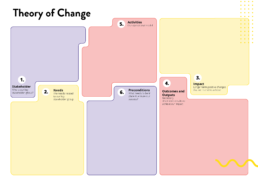
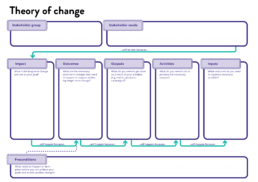
This is a quick explanation of your thought process when creating your theory of change.
Think about your activities.
Now think about your desired impact.
How do your activities lead to your impact?
What are all the steps in between that? Write those steps down according to the guide.
That’s your Theory of Change.
The difference between these two examples.
The first one (6 boxes) is a simpler version. It’s good to use it when you don’t have too much time or when you need to prepare a presentation for external stakeholders. It’s quite easy to read and understand from an outsider’s perspective.
The second one (7 boxes) is a more thorough version. It can be better to use this one when you need to plan or analyse more carefully what your organisation should do or has done.
You can also choose the level of how deep you want to go based on why you decided to create a theory of change. The more specific and detailed it is, the better.
You can either have one theory of change for your entire organisation or one for each beneficiary group if you want to make most of the tool. And an average youth organisation has 1-3 beneficiary groups so it may make sense to create 1-3 theories of change too.
- Fill in the boxes,
- following the numbers in top right corner of each box (6 boxes) or
- according to guiding lines and arrows from left to right (7 boxes).
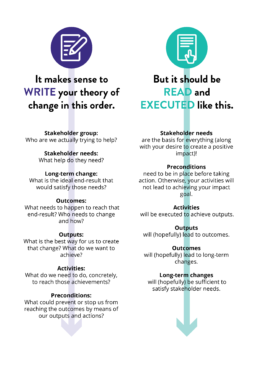
Make use of all information you have written down with previous tools.
- Make sure to differentiate between outputs and outcomes. Outputs are the actions or items that lead to outcomes. For example, a clean-looking website is an output, which leads to increased traction, an outcome. Outcomes describe the change you’ve created (not describing what you did but what happened as a result).
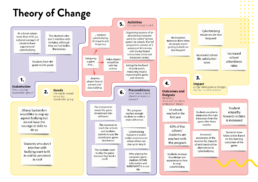
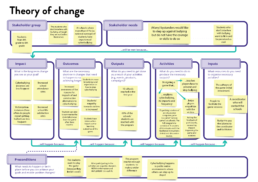
Why to use it?
☑ This is the one tool that covers all the important aspects of planning and managing your impact.
☑ To identify which parts of your work need the most attention to better manage your impact. For example:
- How clearly have we defined our stakeholder group?
- How well do we understand the needs of our stakeholder group?
- How precisely have we defined the outcomes and impacts we would like to achieve?
- What are the necessary and sufficient activities to move from the stakeholders´ current needs to the positive future?
- Which preconditions need to be in place so that our activities would be successful in creating an impact?
☑ The simpler/shorter version of the tool also helps you communicate your aims, activities and impact.
When to use it?
☑ To place the information from the other tools into one place, e.g. from your problem tree, goal tree and beneficiary journey map.
☑ If you have new people joining the team, you can use the theory of change to effectively introduce your organisation and make sure they understand the “big picture”.
☑ You can use it to communicate your organisation externally too, including references in project applications.
☑ It is very useful to come back to your theory of change with your team once in a while to be sure whether you are following your strategy, anything has changed or should be changed.

Beneficiary journey map
A BENEFICIARY JOURNEY MAP helps you understand the experiences of the people that take part in your activities and plan steps to nudge them into the direction of positive impact.
Rūta Žulpaitė (Geri Norai)
“The beneficiary journey map is a tool that should be used quite regularly: for understanding your overall target audience, but also while forming, preparing a new project or activity.
Because most of the time every project or activity could have slightly different service user specification, so it is crucial to analyse it and modify the activities accordingly.
It could also be used as an activity for informal team meetings and team buildings, too.”
What is it?
To design and optimise impactful activities, it is necessary to understand the beneficiaries’ needs, concerns and experiences.
Your beneficiaries are the people who benefit (directly or indirectly) from what you do.
Usually, your beneficiaries are the stakeholders that are the most impacted by achieving your impact goal. In other words – if you achieve your impact goal you will help create positive impacts in their lives.
A beneficiary journey map is a visual representation of the experiences of the people who take part in the activities that you organise to achieve your organisation´s impact goal.
The tool is helpful:
- at the beginning of the design process of the solution to achieve your impact goal,
- whenever there is a need to assess and improve the organisation’s activities by having a look at what the people who are involved in your activities really feel, think and act when coming into contact with you.
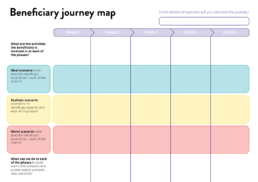
1.Choose a group/segment of your beneficiaries that share similar characteristics, for example, age, gender, interest or socioeconomic status. Then define one typical representative of the group. Be as specific as you can.
In service design, such a typical representative is called a persona. You can read more about creating personas here on this link.
2. Write down the entire process of their interaction with your organization by categorizing it into phases. From the first moment they hear about you to the last moment they think about you! Take also into account the steps that are not covered by your activities but may highly influence the beneficiary´s experience. The process can be as long or as short as necessary and depends on your organization and chosen stakeholder. The more detailed phases you add, the more insights you will probably have.
3. For all phases, write down the ideal situation based on the best experiences the beneficiaries can have, the worst-case scenario that describes the most typical negative situations, and the realistic, most optimal scenario outlining the experiences that most of such types of beneficiaries experience. For all phases, write down the thoughts, emotions, etc. you want your stakeholder to have.
4. Then check out the instances when your ideal is different from reality. Identify actions you can take to move towards your ideal using the question: “What can we do in each of the phases to avoid worst-case scenarios and enable realistic and even ideal scenarios?”
In a nutshell
Think of a group of people that you interact with. Think about an average person from that group. Now put yourself in their shoes and think about what is their experience with you, from start to finish. What does the ideal situation look like? What is the worst-case scenario? What does the realistic scenario look like?
What would you need or like to change about their experiences to achieve more positive impact? In other words – what should you change in your activities to achieve your impact goal better?
You can also have variations in its use
For example, variations in analysis depth.
LIGHT: Write down the keywords based on your (team’s) experience, opinions and gut instinct.
MEDIUM: Involve at least some representatives of the beneficiaries to the brainstorm and/or observe neutrally how the process works out in reality (e.g. what happens during the recruitment or at your events),
ADVANCED: Do some more thorough research to understand the journey and experiences of different segments of your beneficiaries, e.g., some more interviews, focus groups and observations as well as surveys.
Here is an example about a cyberbullying prevention program.
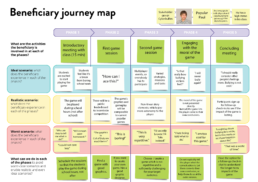
When and why should I use the tool?
The beneficiary journey map helps you to understand the needs and experiences of the persons you involve in and influence by your activities.
As the tool visualises every step of the beneficiary´s journey, it nudges you to think very practically about the design of your activities: what may work well, what can go wrong, what could be improved. When using the tool, it is highly recommended to collect feedback from the users to be sure that we make correct assumptions about their thoughts, feelings and experiences.
The user journey map helps all types of organisations to analyse how their solutions can have more impact on a very practical level, e.g. how to reduce drop-out of the participants during their journey. The tool is helpful at the beginning of the design process of any solution and also whenever there is a need to assess and improve the organisation’s ongoing activities.
Why to use it?
☑ Helps you identify actions you need to take to improve the beneficiary’s experience with you (e.g. to avoid recruiting unsuitable individuals, reduce drop-outs and offer impactful follow-up activities).
By writing down the entire process of how a certain key stakeholder interacts with you, you will understand better:
1) What are the parts of the beneficiary journey that currently block the way to your desired results and impact? You can take action to remove these blockers. These can also be the parts that are not be related to your activities but will still influence whether you can have the intended impact on your beneficiary.
2) Which aspects of that process may be positive or negative to the beneficiary? You can take action to prevent negative situations and strengthen positive experiences.
When to use it?
☑ When designing your activities by considering the experiences that you want your beneficiaries to have at each of the contact points that you have with them to:
- enable their positive experiences,
- reduce their risks of having negative experiences.
☑ Whenever you would like to analyse and improve your activities to achieve a bigger impact by understanding and improving the experiences of your beneficiaries who are involved in your activities.

Stakeholder map
A STAKEHOLDERS MAP helps you analyse and manage relationships with individuals and organisations who are impacted by your solution or who can influence whether your solution will be successful.
What is it?
The stakeholder map helps your organisation to find out who the stakeholders are that you need to focus on if you want to be successful.
The stakeholders can be groups of people (e.g. the youngsters you are working with or the volunteers that help to organise your activities) or organisations (e.g. schools that you need to cooperate with to reach the youngsters or the funders that provide you with grants) or influential individual representatives of organisations (e.g. a Head of Department of a Ministry or a leader of a large umbrella organisation).
The tool helps you to identify, analyse and successfully work with the stakeholders you need to influence to achieve your impact goal and prevent them from influencing your activities negatively.
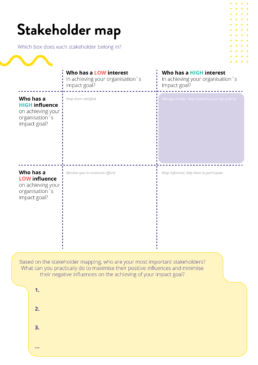
It is useful to first fill in the goal tree because then you will have a clearer idea who are the stakeholders you need to focus on to:
- achieve your impact goal. That is because you usually need cooperation, funding and other actions from the stakeholders to achieve something as big and ambitious as your impact goal likely is,
- ensure the existence of the preconditions that need to be in place for your success. That is because ensuring the existence of the preconditions usually depends also on the actions of your stakeholders.
This is what you should do.
1.Identify and map the activities that you need to undertake to achieve your impact goals. Include the activities that are needed to ensure the preconditions of achieving your impact goals. You can identify these preconditions with the help of the goal tree.
2.Brainstorm and write down all the stakeholders that are or may be important from the perspective of achieving your impact goal. Who can influence the success of your activities? Who will you influence with your activities and need to take responsibility for?
As mentioned before, the stakeholders can be groups of people or organisations or influential individual representatives of organisations.
3.As you have already identified your stakeholders during the brainstorm at the previous step, place each of their names in an appropriate cell of the stakeholder map diagram. Placing the stakeholders would work the best with (virtual or physical) post-it notes: one note per stakeholder.
The exact location can be determined with the help of the scale. For example, the stakeholders with the lowest interest and highest influence in relation to achieving your impact objective (e.g. the potential participants that have currently a negative image of your organisation) should be placed on the top left side of the table.
Finding appropriate places for each of the stakeholders may take some time and discussion among your team as the team members may have different views about the relative interest and influence of your stakeholders.
4.Analyse your stakeholder map and make choices about the steps you need to take to manage the stakeholders that you need to influence and have a high impact on your success.
Two questions to help you have been provided:
- Who are your most important stakeholders?
- What can you practically do to maximise their positive influences and minimise their negative influences on the achieving of your impact goal?
You can watch the video to get an idea of what the tool is about or continue reading after the video player.
In a nutshell…
Decide about what you want to achieve: create a goal tree and identify your impact goal.
Then map the stakeholders:
- who you want to have an impact on,
- who can support you in / prevent you from achieving your goals.
The stakeholders can be groups of people sharing similar characteristics or organisations or influential individual representatives of organisations.
Write the stakeholders down in a list. Then put them in the following four categories and write down concrete actions to take (if needed) about each of the stakeholders.
- Who can very much help you or get in your way AND are really interested in what you are doing? Put the most effort into making these people or organisations involved and happy. If they want to prevent you from achieving your impact objective, you can plan to take necessary preventive measures.
- Who can very much help you or get in your way AND are not really interested in what you are doing? You have to make sure these people or organisations are happy with your work, but don’t put too much effort in – after all, they are not really interested.
- Who can’t really help you or get in your way AND is really interested in what you are doing? Since they are interested, keep them informed, but don’t put in too much effort, since they can’t help you much.
- Who can’t really help you or get in your way AND is not really interested in what you are doing? Put the least effort into interacting with these people, if any at all.
You can also have variations in its use
LIGHT: Write down the keywords based on your (team’s) experience, opinions and gut instinct.
MEDIUM: Involve the representatives of the stakeholders in creating the stakeholder map.
ADVANCED: Do some research to understand better your stakeholder groups and differentiate between segments inside the stakeholder groups with varying degrees of “influence” and “interest”. The research can include interviews, focus groups and asking for expert opinions.
Here is an example about a cyberbullying prevention program.
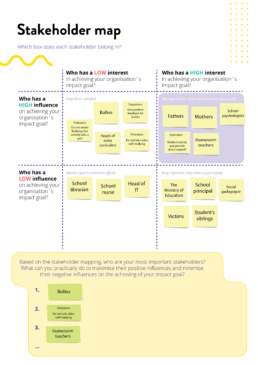
Why to use it?
☑ To understand who exactly are the different groups of people and organisations that you need to involve and influence to achieve your impact objectives, e.g., young people you are directly working with, or the adults whose actions have a direct impact on the young people that you want to help.
☑ By using the stakeholder mapping tool you prioritize the stakeholders by the amount of influence and interest they have over achieving your impact objective. You can use this tool to choose which actions to take with each stakeholder and prioritise how much time to spend on them.
☑ To take responsibility for your actions that may negatively influence some groups of people during your activities. It is especially important regarding these stakeholders who have no power to directly influence your activities that might have a negative impact on them (e.g. young people who would develop quicker in other programs and thus waste their potential by participating in your activities, or youngsters who are required to attend your programs by other adults like their parents or social workers).
When to use it?
☑ Before developing your short-term objectives and activities (e.g. after choosing your impact objective and completing the goal tree based on the impact objective).
☑ When you want to make sure that you have identified all the risks and opportunities related to the groups of people and organisations who may have the interest and/or power to influence whether you will achieve your impact objective or not.

Goal Tree
A GOAL TREE helps you design and communicate your solution to the societal problem by analysing the preconditions and impacts of your success.
Tadas Bartasevicius (MB Spanguolės dirbtuvėlės)
I found this tool very beneficial in equally including my team in the decision-making and idea generation processes.
Using the model of the tool, we provide our own activity ideas as solutions to the problems our social business is trying to solve.
Erik Mikkus (Estonian National Youth Council)
I was a guest in a national radio programme and talked about why young candidates aren’t ofter popular in local elections.
The solution tree gave me a systematic approach and clear structure to the issue and helped me prepare for the talk.
What is it?
The goal tree is very similar to the problem tree. It is an easy-to-use tool for specifying what needs to be done to achieve your organisation’s goals and what the impacts are or (hopefully) will be thanks to your success.
This tool helps you understand:
- what you need to be put in place to achieve your goal;
- what good things you can expect to happen if you are successful.
Analysing the first point can help you see what could block you from achieving the goal and solving the problem – so that you could prevent those blockers as early as possible!
The second point helps you understand what can be the impacts if you are successful at achieving your goal. You can use the knowledge of these impacts to communicate the usefulness of achieving your goal and observe if these impacts are really happening when you think you have achieved your goal.
You can watch the video to get an idea of what the tool is about or continue reading after the video player.
In more detail…
1.Write down the goal that you want to achieve as a result of your activities to solve a social problem. If you have already completed a problem tree, you can choose the problem and turn it into a positive goal from that tree. You can also call it your impact goal because achieving this goal means creation of your positive impact too.
2.Write down the preconditions. Imagine working towards the goal and reaching it. What needs to be in place or happen before achieving the goal? What do you need for your plan to work as intended? Is there something you assume to be true, but might not be? For example, getting the preconditions in place may mean tackling some of the root causes of the core problem that you intend to solve or establishing new partnerships to have sufficient resources to achieve the goal.
3.Write down your desired results and impacts, which will occur if you are successful at achieving your goal. What will be the first results that will probably be visible in the shorter term after achieving your goal? What good things can happen thanks to the shorter-term results? Etc.
4.Analyse the goal tree and make choices about your mission and activities. For example, are there any important preconditions that you have not yet ensured? Do you measure the most important results that have been identified thanks to the goal tree?
You can also have variations in its use
Variations in certainty.
LIGHT: Write down the key words based on your (team´s) experience, opinions and gut instinct.
MEDIUM: Involve other organisations, ask for expert opinions, include the viewpoints of the stakeholders that have different experience and values compared with your team.
ADVANCED: Only include causes and consequences that the scientific research and literature has shown to have clear links to the main problem.. E.g. you may think that you may be able to reach certain desired impact by you activities. However, if there have been no studies to prove such possibility, you should not include it to the goal tree.
Why use it?
☑ To make it easier to translate the needs and challenges shown on the problem tree into you impact goal and activities to achieve the goal.
☑ You will better understand what needs to happen before you can achieve your goals. In other words – what are the preconditions that need to be in place before you can be successful. Thanks to this knowledge, you can make efforts to ensure these preconditions. Alternatively, you may decide to identify a new goal if you will see that ensuring the preconditions of your initial goal is not realistic.
☑ You will more precisely identify the results and impacts that will happen thanks to providing your solution, you can communicate the value of your organisation’s work. Also, you may decide to measure at least some of these results and impacts to be sure that achieving your impact goal has really been valuable to the beneficiaries and society.
When to use it?
☑ When developing your impact goals and activities based on the problems that you want to address.
☑ When analysing how you could increase the likelihood of your success by addressing the preconditions of your impact goal. “Addressing the preconditions” means taking action to ensure that these preconditions may be in place.
☑ When analysing whether your impact goals are achievable. If some of the core preconditions cannot be ensured, you should probably change your impact goal into a one in which preconditions can be better met.
☑ When creating indicators that you will use to measure your results and impacts (by identifying all the good things that happen thanks to achieving your impact goal).
☑ When you need to explain your organisation’s work internally or externally, e.g. why you are organising some of the activities (to ensure necessary preconditions of your success) or what the wider value of your organisation´s work is (in case you achieve your impact goal).

